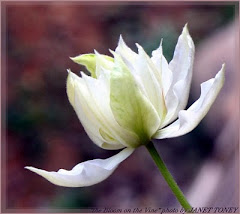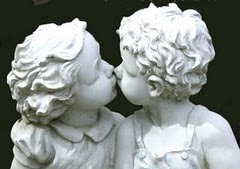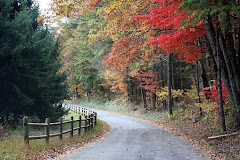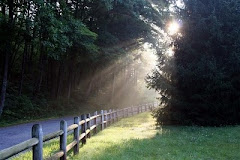
I simply placed all the furniture in the middle of the room and piled the smaller items from the room on top of the furniture. You may need to take things out of the room if there isn't sufficient space for your ladder and small table.
You'll want to keep mud and paint off your furniture and other items. I used some cloths I keep for this kind of thing, to cover everything. You might use drop cloths or old table cloths etc.
Before you begin you must tape off your wood work, around the windows and doors, maybe the ceiling from the wall and unless you take all the switch plates and vent covers off you will need to tape over their edges. This blue tape is recommended.
You will leave the tape in place until you have finished the texture and painting.
Next you will set up your ladder, and find something to put your pan of mud onto so you can reach it when you're up on the ladder. I used a tall kitchen stool, one that it would not hurt to get paint or mud onto.
Mud pan, and two mud knives.
Mud.
Fill the mud pan full of mud, pick up a glob of mud on your triangle shaped mud knife and spread the mud in small swatches across the wall in a random pattern. I turned the knife one way and then another across a section and I left some smooth flat wall between each swatch. You will want to be sure to get some near the ceiling here and there and some next to the wood work or corner or what ever 'edge' there is so that you don't end up with rows of flat wall around the edges of your wall.
Once you've used all the mud on the knife, switch to the trowel, lay it over the mud, press it against the mud and wall, and twist, pull down and/or across the wall. Next you will pull the trowel off the wall. This will take some effort. You will notice this action will make little projections of mud stick out from the wall. Decide if you like these. If you do, continue to first spread the mud in this section and then begin to push the trowel in and pull it out in a random way across the section of wall. You will be pounding the wall with the trowel. Every place the trowel is pulled away, if there's enough mud, you'll have the raised projections. For added texture use the side of the trowel and hit the wall in one direction and then another, a right angle then a left angle, over the section of wet mud.
Your design for the texture is only limited by the properties of the mud and tools and your use of them. There are no hard and fast rules other than a pattern once established will look nicer if it is repeated throughtout the entire wall and/or room.
Painting over the pulled up spikes isn't easy, so you may want to try to make them less pronounced or skip them all together. Pulling, twisting and turning the trowel will make very interesting designs in the mud.
Your wall should look something like this one.
You will continue the above described process until all the walls are covered. Try to use the same system throughout, so the walls while having a random pattern, the pattern will also be the same over all.
Now you get to rest for at least a day before you begin painting.
Especially if you have made the pulled up texture on your walls, you will need to either use a large or rollers for ceilings or stucco.
I used a brush. You don't always need to use the most expensive brushes. I used the less expensive ones and they held up for both bedrooms. Since they weren't expensive I didn't feel guilty throwing them away when my rooms were finished. It saved a lot of messy clean up. A smaller trim brush is very helpful for near the ceilings, wood word and switches.
You will either need to cover all the walls with a primer and then paint them or use a paint with a primer in it.
This is the paint I used. It's new at the store where I bought it, and I was a little worried about how well it would cover. It worked just fine. The areas of mud are a little bit duller looking but since I wanted a varied look, this is a good thing. I'm also happy with the semi-gloss because it can now be washed off easily. The walls shouldn't need repainting for several years.
When you have finished painting give the walls a couple of hours of drying time and then remove the tape, and reassemble your room.
Texturing gives an interesting look to your walls, and it will hide small dings. And, you won't have to worry about filled nail holes showing when you decide to move your artwork or pictures from place to place. Remember to have some extra paint in a sealed container, such as a jar with a tight lid, so you can paint over the repaired nail holes.
The process is not difficult to master. It is a bit time consuming and it takes some physical effort but most anyone who really wants to texture her walls, can.
You can see my earlier post for pictures of my rooms after they were textured and painted.






.jpg)









Wow I really love your posts!
ReplyDelete